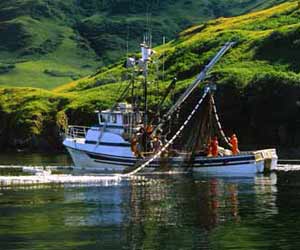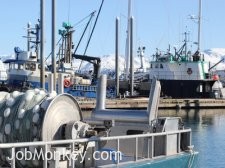Fishing Boat Deckhand and Seafood Processor Jobs
Alaska fishing industry jobs can be divided into two categories: harvesting and processing. Anyone seeking work in the industry must decide which of these to pursue. Seafood processing occurs both at onshore plants and on boats, while harvesting is the actual process of catching fish. The latter is where you can pursue deckhand jobs on fishing boats.
The easiest way for a newcomer to break into the industry is with a seafood processing job. Either at onshore plants or on floating vessels, processing companies hire numerous entry-level workers to deal directly with the fish that have been caught. These positions include slimers, packers, clean-up crew members, machine operators, and office staff.

Harvesting or deckhand positions are more lucrative, specialized, and thus more difficult to obtain. Net repair, wheel watching, net hauling, and rigging are just some of the responsibilities of harvest workers.
The sections below explain in greater detail the differences between harvesting and processing.
Harvesting Fish
Harvesting simply means catching the fish – it’s what some job seekers think of as fishing boat jobs. Harvesters (or fishermen) often are expected to work long hours in cold, wet weather under exacting conditions. Though not all positions on these boats require extreme physical strength, they do require good endurance; eighteen-hour days are not uncommon. Anyone wishing to work on a boat, as a deckhand for instance, should keep in mind that there are sometimes very real dangers involved. Every year, a few boats are lost in the icy waters, so the decision to work as a harvester should not be made lightly.
The harvesting part of the fishing industry can be further broken down into individual fishing boats and large catcher/processors. Small fishing boats – including purse seiners, gillnetters, and trollers – do not usually do their own processing. Rather, they ice their catch and off-load it to tender boats or onshore processing plants. These vessels are usually independently owned, and employment practices are up to the whim of the captain. Catcher/processors are larger vessels that process what they catch while at sea.
As well as being more strenuous and hazardous, working on a boat is more financially rewarding than processing at an onshore plant. It’s true that some processors work on fishing vessels, but it’s the deckhand position on a harvesting vessel that can earn you big bucks. During a good salmon season deckhands often earn $5,000 or more in a month. Deckhands working on crab, herring, or longline boats can make even more. For those who really want to make money and are not fazed by mild physical discomfort, working on a boat is the way to go. Anyone who wants to work as a deckhand, an offshore processor with hopes of working up to a deckhand job, or just anyone who loves being at sea should concentrate on the Offshore Industries.
To learn about becoming a fishing boat deckhand and to search a database of detailed profiles of all fishing boats licensed to fish in Alaska, go to www.AlaskaJobFinder.com.
Seafood Processor Jobs
Although not as physically demanding as harvesting, processing is also taxing work. Processing involves relatively little physical risk, but requires working very long hours performing repetitive and often undesirable tasks (e.g., gutting salmon). Processing jobs are plentiful and easier to find than harvesting jobs, and require neither experience nor exceptional strength. Most first-timers to Alaska work in shoreside processing facilities, which include both fresh frozen plants and canneries. Many also do processing work on vessels (factory trawlers, crab catcher/processors, factory longliners, or floating processors).
A newcomer to the industry summed up his experiences working shoreside in Alaska:
“Last summer I worked in a salmon cannery in Ketchikan and made a little less than $6,000. They had a brand new bunkhouse and good food. The best part was the other college students from around the country that I had the chance to meet and work with.”
The pay for these jobs is lower but more reliable than that for harvesting jobs. While fishing boat owners typically compensate deckhands with a percentage of the boat’s profits, processing companies usually pay by the hour (minimum wage is the base wage for newcomers, plus time-and-a-half for overtime). Alaska state law requires companies to pay overtime wages to people who work more than eight hours per day or 40 hours per week. It is pretty simple for a processing worker to predict how much he or she will earn in a given week of work. Entry-level processors can easily earn $1,000 to $1,300+ a week during the season’s peak. Readers interested in summer processing positions should concentrate on The Onshore Industries.
To find all the latest jobs with onshore and offshore processors, go to AlaskaJobFinder.com. Their website isn’t free but the initial subscription is only $3.95. Details are available on their website.


 Teach English in Asia
Teach English in Asia  Cruise Ship Jobs
Cruise Ship Jobs  Alaska Fishing Industry Jobs
Alaska Fishing Industry Jobs  Sharing Economy / Gig Economy
Sharing Economy / Gig Economy